Abstract— Avionics is predominantly a slow adapter of the latest technologies, due to the nature of the business. As it involves a lot of security and safety, field failures can cause severe loss of life, assets, and brand of the airlines e.g. Boeing 737 Max crash cause huge loss to the company and airline business. But lately with the entry of UAM and air taxi market conventional avionic started to adapt to modern technologies slowly. The regulatory bodies also play a pivotal role to facilitate the invention as reliability and fail-safe is their topmost priority for commercial avionics systems. To keep up the pace with the latest innovation and current demand for connectivity airlines are interested in 5G technology. The expected benefits of 5G may completely revolutionize the aerospace industry the potential is enormous. The testing with UAM or air taxi also provide more confidence to commercial avionics regarding its reliability and use cases.
Traditionally avionics systems consist of communication services, surveillance services, ground proximity systems, transponders, instrument landing systems, GPS, and in-flight entertainment systems. There is a pre-assigned frequency spectrum for all these essential functions by the regulators. Now with the invention of 5G and its broad frequency spectrum, several of these functions can be transitioned over the 5G spectrum and utilize its speed, agility, and availability of the network. But it is not as simple as it looks as every proposed system needs to be tested over a period in service before bringing it to commercial use. The objective of this paper is to identify possible used cases of 5G in the avionic system and propose a system architecture of one such used case with a focus on efficiency.
Keywords— 5G, safety and connectivity systems, communication, wireless
I. INTRODUCTION
The new communication technology of 5G mobile communications will be going to impact the Air-to-Ground communication and Air-to-Air commination, which can also have performed as a node for 5G communication network. 5G use of avionics confronts different types of challenges than the regular communication network like high safety, large capacity of transmission, relatively very low latency, high range of elasticity, and synthesis of essential and other network services.
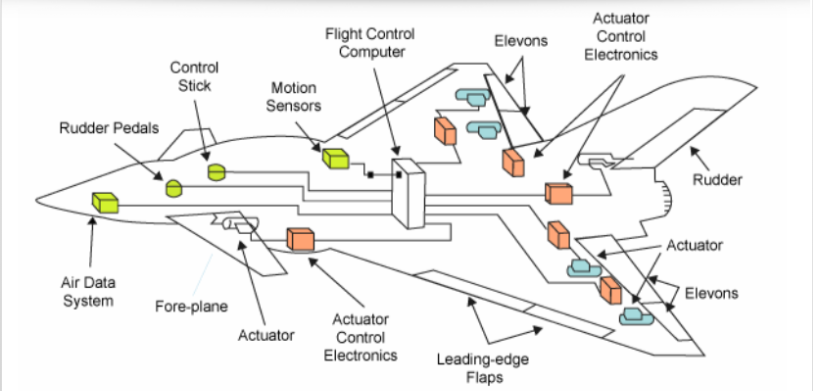
Figure 1 FLY-BY-WIRE Modern Electronics Flight Control System
Currently, the aerospace industry is trying to innovate the below 3 problems:
- Wireless secure connectivity of fly-by-wire flight control systems Figure 1.
- Improving the aircraft communication and navigation systems for both Air-to-Air and Air-to-Ground.
- Uninterrupted high-speed connectivity of internet and inflight entertainment system Figure 2.
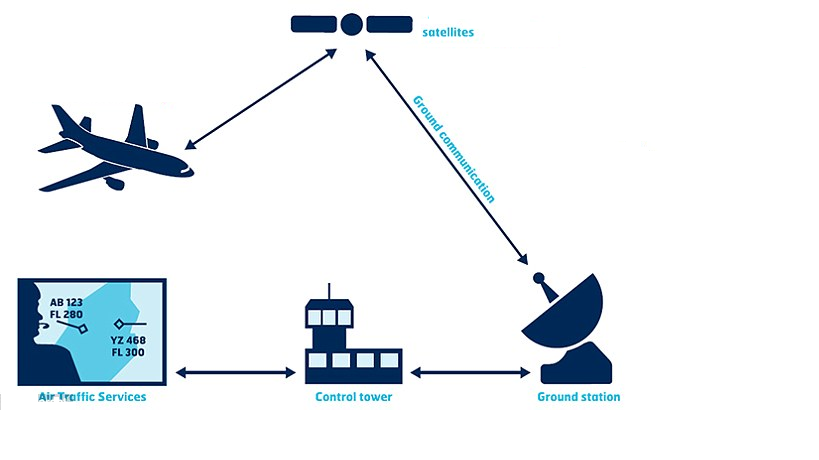
Figure 2 Satellite Communication
Avionics always has dedicated bandwidth for all its applications to make sure reliability, availability, and stringent regulatory watch. With the invention of 5G which goes way beyond the allocated frequency spectrum research is going on to use that spectrum to make the system more reliable safe and fast.
II. FIFTH GENERATION(5G) WIRELESS COMMUNICATION TECHNOLOGY
Connectivity today is as essential as electricity in our society, wireless networks require to be always on and available everywhere. Fifth-generation (5G) wireless communication enables:
- Speeds and feeds: up to 20 Gbps will be achieved by a combination of innovations such as carrier aggregation, massive multiple input multiple output, and quadrature amplitude modulations.
- Unlicensed spectrum: increasing carrier utilization of mobile network operators making it more congested. 5G networks will have the luxury of a large amount of spectrum available in currently unlicensed bands to avoid congested areas and provide connectivity.
- Video and gaming everywhere, all the time
- High quality of service (QoS)- service that’s secure and reliable
- Industrial and manufacturing efficacies
- On-demand everything and anything
- Mobile network operators will be benefited by
o Ability to meet explosive demand of mobile data
o Reduction of cost per data bit
o Data related business models - Virtualization: Mobile network operators want the network function virtualization which enables the scalability and elasticity of the network.
- 5G New Radio: it should use the modulation schemes, waveforms, and access technologies to support speed up to 20 Gbps.
In 5G the operating frequency bands are divided into two frequency ranges: frequency range 1(FR1) and frequency range 2 (FR2). FR1 is usually called sub-7 GHz and FR2 is the 5G millimeter-wave frequency range.
| Parameter | Frequency Range 1(FR1) | Frequency Range 2 (FR2) |
|---|---|---|
| Name | 5G Sub- 7 GHz | 5G mmWave |
| Frequency Range | 410-7125 MHz | 24.25-52.6 GHz |
| Transmission Bandwidths | 5-100 MHz | 50-400 MHz |
| Sub Carrier Spacing | 15 kHz, 30 kHz, 60 kHz | 60 kHz, 120 kHz, 240 kHz |
| Carrier Aggregation | Up to 16 carriers | Up to 16 carriers |
| Waveform & Modulation | Cyclic prefix-OFDM, Discrete Fourier Transform Spread -OFDM, QPSK, 16 QAM, 64 QAM, 256 QAM | Cyclic prefix-OFDM, Discrete Fourier Transform Spread -OFDM, π/2-BPSK, QPSK, 16 QAM, 64 QAM, 256 QAM |
| MIMO | Up to 8 layers in DL, Up to 4 layers in UL | Up to 8 layers in DL, Up to 4 layers in UL |
| Deployment Applications | Macro cells/ many mobile users/ long-range | Small cells/ less users/ increased content/ short-range |
| Challenges | Spatial multiplexing-delivers multiple parallel streams of data in the same resource block | Beam steering for each mobile user |
| Spectral Efficiency | High, because of spatial multiplexing | Low spectral efficiency- less users and high pathloss |
| Channel Characterization | Rich multi-path propagation | Few propagation pathways |
| Number of Simultaneous users | Tens of users, large coverage area | Few users, small coverage area |
III. TECHNOLOGIES THAT ENABLE 5G
A. Carrier Aggregation (CA)
CA combines multiple mobile network operators into one data channel to increase data rates in the system with optimized usage of available bandwidth. For example, 2CA enables any of the four carrier bandwidths (5, 10, 15, or 20 MHz) to be used as the primary carrier and any of the other four carrier bandwidths to be used as the secondary carrier.
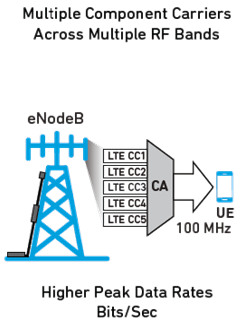
Figure 3 Carrier Aggregation
B. Massive MIMO and antenna array systems
Massive MIMO technology uses large antenna array systems which combine the RF transmit and receive chains into each array unit and typically are composed of 16,32,64 or more array elements.
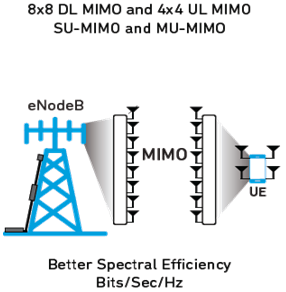
Figure 4 Spatial Multiplexing
C. Spectrum sharing
Dynamic spectrum sharing is an intelligent way to minimize waste and optimize the spectrum to enhance the end-user experience. As an example, if FR1 and FR2 can double the coverage area in spectrum sharing mode.
D. Quadrature amplitude modulation (QAM)
The technique of QAM can carry higher data rates than other amplitude modulation and phase modulation schemes. In QAM the constellations points are arranged in a square grid with equal vertical and horizontal spacing. To transmit more bits per symbol higher-order modulation formats are required. But increasing the order of QAM brings the points closer together and more susceptible to noise and data errors. 1024-QAM and even 4096-QAM are also under evaluation in 5G techniques.
E. Fixed wireless access (FWA) with mmWave technology
This gives flexibility to wireless operators to increase their home internet speed many folds than the wired broadband providers. It promised to give gigabit of speeds to businesses and homes in a fraction of the time and cost of traditional cable and fiber installations refer Figure 5.
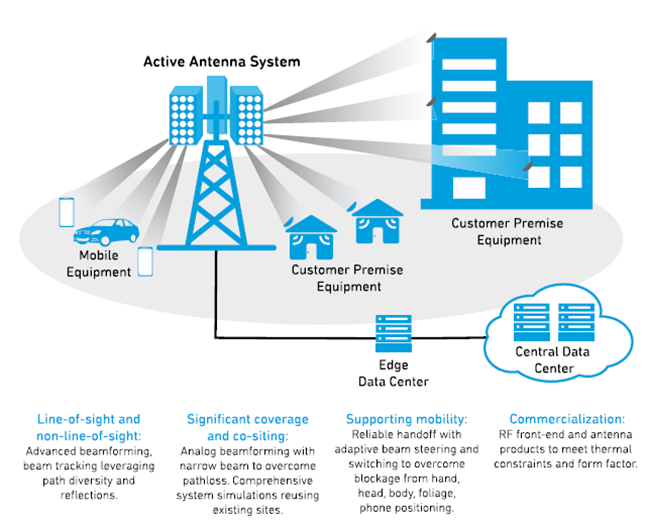
Figure 5 End-to-end FWA network and benefits
IV. CHALLENGES WITH 5G TECHNOLOGY
Millimeter waves have poor transmission, it is susceptible to high attenuation and can’t penetrate walls.
Security is the next big challenge, how to protect safety and connectivity services, ground operations, and personal usages on the same spectrum.
Link reliability, integrity, and continuity.
Range (which is tightly coupled to available RF power, receiver sensitivity, antenna gains)
V. USED CASED OF 5G IN AVIONICS SYSTEMS
Over the last few years, the mobility industry has seen multiple changes in technology which brings disruption to all the value chains from OEMs and suppliers to users. The aerospace industry is no exception as the growing demand of users for connectivity along with reducing the weight of wiring in an aircraft is a long-time problem of OEM’s. OEM’s are also looking to solve the maintenance of avionics systems remotely which forces suppliers to look for disruptive technologies in the mobility industry to use in avionics. 5G use cases are becoming more and more well-articulated by the industry and the ultra-high reliability and low latency of 5G come into the future. As 5G is the next revolution in aerospace by various experts.
A. Smart Connected airports
Airport operators need to reduce operating expenditures while generating revenue by attracting airport tenants with fixed and wireless access, as well as passengers with enhanced broadband services. At the same time need for a network that meets the capacity demands for next-generation communications services. And they want to do all this on a single mission-critical, multiservice network, avoiding the costs of siloed networks using multiple technologies run by different managers.
B. Air Traffic management (ATM) communications
Ground-to-ground ATM is about meeting the regulatory and technological demands of the evolving global civil aviation system. To ensure safety, ATM operators must ensure mission-critical operations, as well as support for new applications, such as collaborative decision-making and dynamic air-space management. At the same time, efficient use of resources and overall lowering of OpEx is imperative.
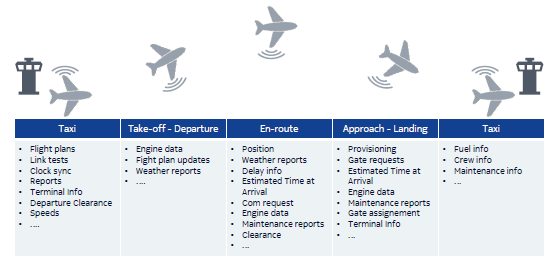
Figure 6 Aircraft information exchanges stages
As the key management stakeholders for future air navigation system-based ATM services, air navigation service providers must operate mission-critical networking infrastructures that connect the following:
a) All Very high frequency (VHF) and very high-frequency data link (VDL) stations
b) Automatic dependent surveillance ground stations (ADS)
c) Advanced surface movement guidance and control system ground stations (A-SMGCS)
d) Differential global navigation satellite system (GNSS) ground stations
e) Control towers
f) Air traffic control centers
g) Primary and secondary radars
h) Weather stations
i) Instrument landing systems (ILS)
C. In-flight broadband internet access with LTE
Air passengers across the globe are expecting fast, reliable broadband services during flights. This demand is increasing, with increasing air passengers using smartphones, tablets, and laptops. Airborne connectivity is relatively new for most air passengers but the growing demand for speed like the ground is desirable and OEM’s and suppliers are working to give best-in-class in-flight connectivity as there USP for passengers.
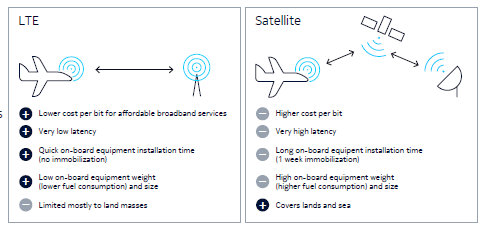
Figure 7 Comparing air to ground and satellite communications
D. Drones
The drone ecosystem has not fully developed because it cannot work on internet networks. No standard network, up until now, has combined low latency rates with high-density networks. Now, both are supported on 5G networks, which will help to develop the drone’s ecosystem rapidly fast. 5G will help drones to operate very low-level airspace to provide citizen services.
VI. OBSERVATION
- 5G mobile communication technology has enormous potential for application in civil aviation.
- Security and privacy are the most important challenge that 5G needs to ensure in avionics as well as personal data.
- Cost to buy, cost to acquire, cost to maintain and support, cost of equipment, as well as a challenge, need to be addressed by 5G
- 5G also needs to address the challenge of scaling and processing to full fill promised performance.
VII. LIMITATION 4G VS 5G
The inevitability of 5G wireless networks is since the current 4G networks are limited in data capacity and speed. Compared to 3G wireless networks, 4G networks achieved performance improvements by means of enhanced spectrum efficiency, typically using advanced modulation and coding techniques. Antenna techniques such as MIMO schemes also helped increase spectrum efficiency in 4G systems as well as the use of novel radio technologies, such as OFDM, to make better use of the available spectrum. These improvements have made possible relatively fast data transfer rates in 4G/LTE systems, as fast as 1 Gb/s for stationary devices and about 100 Mb/s for moving mobile devices communicating through the network. But proponents of 5G wireless networks note the capacity requirements of so many IoT devices and the growing demands for fast data transfers and streaming video, with the expectation that 5G systems will operate at 10 times the speed of 4G/LTE networks, or at 10 Gb/s.
The capacity of a wireless network is affected by several factors, including the available bandwidth, the number of communications channels, the number of cells, and the signal-to-noise level of the system. By adding bandwidth in the form of mmWave frequencies, 5G wireless networks can gain capacity, but system planners hope to do so without a significant increase in energy consumption, a requirement that will impact the design of PAs for 5G networks, whether at mmWave or lower frequencies.
VIII. 5G AND SATELLITE SYSTEMS BASED AIRCRAFT COMMAND AND CONTROL, NAVIGATION AND SURVEILLANCE
Avionics communication is expected to be a vital component of 5G communications. This includes the use within mobile architectures and the same for satellite-based communications. There can be a dedicated and protected aviation spectrum for commercial, cargo, and other piloted aircraft for safety concerns. But since the spectrum availability of 5G is not a concern this can be done easily. The communication link is dedicated to secure and reliable communication between the pilot and ground control station to ensure safe and effective flight operation. This link can be either a line of sight air-round link or a beyond the line of sight link using another platform such as a satellite or high latitude platform. Data rates of such links are expected to be modest (as currently, we are not discussing inflight entertainment system but same can be extended in future).
5G technology brings large bandwidths for communication applications. The large available bandwidths allow fast commands, possible transmission of all types of data in the same physical channel. In the Below communication framework, all communication links utilize the same frequency band of 5G. Which allows the avionics to have common hardware for ground and satellite communications.
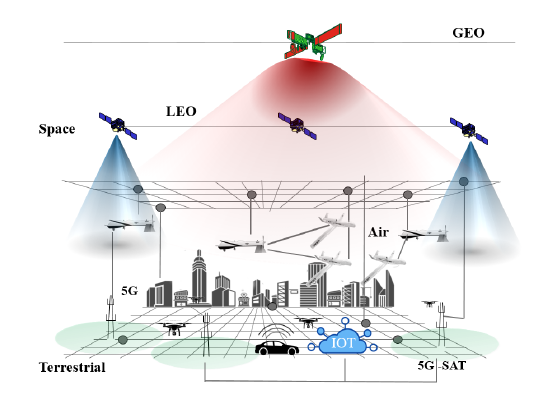
Figure 8 5G Based Aircraft Communication Architecture
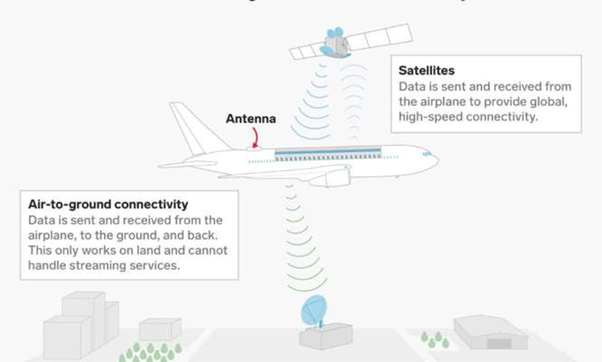
Figure 9 Switching of Communication on Need basis

Figure 10 Block Diagram to proposed 5G Avionics System
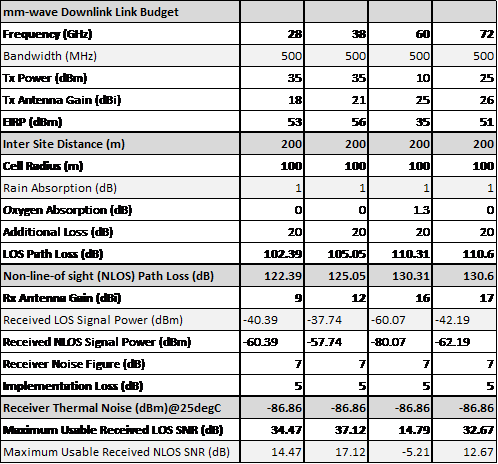
Figure 11 mm‐wave Downlink Link Budget

Figure 12 Satellite Up Link Budget
IX. CONCLUSIONS
In this paper, we reviewed 5G technology and its key characteristics to fit in avionics applications. We also reviewed the various used case for the utilization of 5G technology in the avionics domain. An architecture that can meet both satellite and ground communication based on 5G has been presented with link budget calculations. We also discussed critical navigation and surveillance techniques based on the 5G link. It has been noted that very high reliability is required for navigation systems.
REFERENCES
- D.Y.C.Lie, J.C. Mayeda, Y.Li and J.Lopez: A Review of 5G Power Amplifier Design at cm-Wave and mm-Wave Frequencies, In Proceedings of Wireless Communications and Mobile Computing Volume 2018 Article ID 6793814, 16 pages https://doi.org/10.1155/2018/6793814
- Cicek Cavdar, Damini Gera, Ayan Ghosh, Sandra Hofmann, Anders Nordl ¨ow and Dominic Schupke: Demonstration of an Integrated 5G Network in an Aircraft Cabin Environment. 2018 IEEE/AIAA 37th Digital Avionics Systems Conference (DASC)
- Lu Ma, Chao Zhang: 5G waveforms design for aeronautical communications. 2016 IEEE/AIAA 35th Digital Avionics Systems Conference (DASC)
- Aygün Baltaci, Samuele Zoppi, Wolfgang Kellerer, Dominic Schupke: Evaluation of Cellular IoT for Energy-constrained WAIC Applications, 2019 IEEE 2nd 5G World Forum (5GWF)
- Nozhan Hosseini, Hosseinali Jamal, Jamal Haque : UAV Command and Control, Navigation and Surveillance: A Review of Potential 5G and Satellite Systems. 2019 IEEE Aerospace Conference
- Theodore Zahariadis, Artemis Voulkidis, Panagiotis Karkazis : Preventive maintenance of critical infrastructures using 5G networks & drones. 2017 14th IEEE International Conference on Advanced Video and Signal Based Surveillance (AVSS)
- Jose A. del Peral-Rosado, Olivier Renaudin, Christian Gentner: Physical-Layer Abstraction for Hybrid GNSS and 5G Positioning Evaluations, 2019 IEEE 90th Vehicular Technology Conference (VTC2019-Fall)


 Ratnesh Kumar Gaur
Ratnesh Kumar Gaur